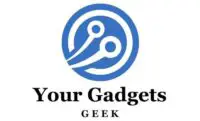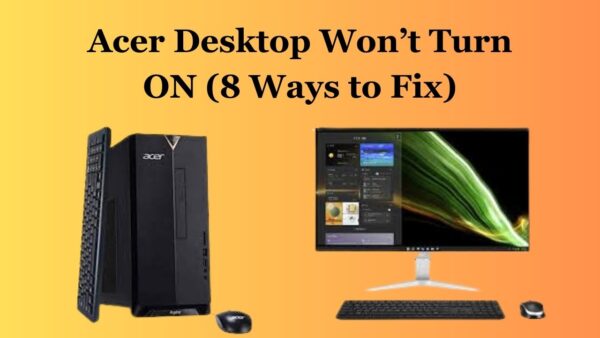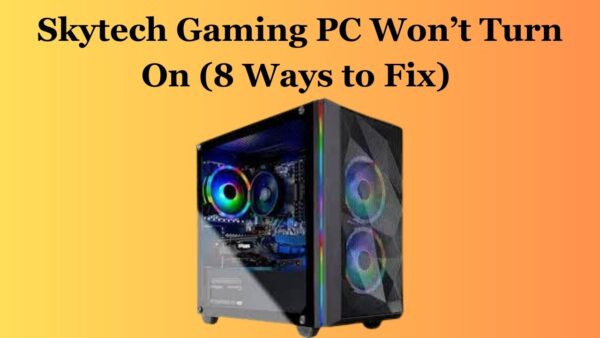I couldn’t believe my eyes when I turned on my beloved NZXT PC, only to be greeted by a blank screen on my monitor.
Panic rushed through my veins as I wondered what could have gone wrong. Had I accidentally pressed the wrong button?
So, I researched online, and after struggling for a few hours, I found my PC displaying back on the monitor.
In this article, I’ll show you why your NZXT PC isn’t displaying on the monitor and how you can fix it.
Let’s begin!
How to Fix NZXT PC Not Displaying On Monitor
You should follow these possible solutions to resolve your PC that isn’t displaying on the monitor.
1. Ensure Monitor Is Powered On
Firstly when your PC isn’t displaying on the monitor, you should ensure that the monitor is connected to the power outlet and completely turned on.
Most of the monitors have an LED that lights up when it is powered on. So, you should check if an LED lights up on your monitor.
If the monitor doesn’t show an illuminating LED, you can power cycle it. Power cycling and checking all cables will turn the monitor on.
However, if the monitor is not getting power, you should check your power outlet/ strip to see if it is faulty. You can plug the monitor into the other power outlet and get the monitor turned on.
2. Check Video Cables
Next, check your display/ video cables connected to the HDMI or DP port between the motherboard or GPU.
You should ensure the video cable is properly inserted all the way into the port. And you have inserted it into the right port on your monitor and PC.
Most modern monitors & PCs connect the computer with HDMI and Display Ports. However, a Display Port connection is recommended for highly refreshed monitors.
If the PC is still not connecting to the monitor, you can check the display port because it can be dusty. You should clean the port and reinsert the video cable firmly.
Turn your PC on and check if it is working back on the monitor. If still the problem persists, you can use another HDMI port on GPU or motherboard.
3. Change Monitor Input
Most monitors have multiple input connection options. When you connect your PC, you’ll need to select the correct input source from the settings using the monitor’s built-in on-screen display menu.
Ensure that you’ve set the monitor to automatically detect input. Let’s take a look at an example:
If you have a monitor with two HDMI and DisplayPort input types and you’ve connected the GPU and monitor using a DisplayPort.
Then you’ll need to select the DisplayPort as input; if you select input source HDMI, it will result in no display on the monitor.
As we discussed, your monitor might have several input options, such as; HDMI1, HDMI2, VGA, or DP.
So, you will need to select the right input source on your monitor that matches the port connected to the GPU.
4. Use other Display Options
Almost every computer or monitor has multiple display options, such as HDMI, VGA, DVI, USB-C, or DisplayPort.
If you are using the HDMI connection between your PC and monitor and it isn’t working, you should try the different HDMI ports/ other video cables.
You can buy a new VGA or USB-C cable and try connecting the PC to check if the problem resolves.
However, if your device doesn’t have other options, instead of the HDMI port, you can use HDMI to VGA or USB-C converter and connect the monitor.
5. Check All Hardware
If you’ve recently paired/ attached a hardware component to your PC and after this, it isn’t displaying on the monitor, you should disconnect/ unplug that particular component.
If it doesn’t resolve the issue, you should troubleshoot all the hardware components connected to your computer.
You should disconnect all the devices and test each hardware component individually until you find the problem.
Once you find faulty hardware such as a; keyboard, mouse, or other USB drives, you should take it to an expert.
6. Fix RAM
The RAM is another essential component in your PC, a temporary memory on your device. Your PC uses it to save data, and RAM keeps that data easily accessible for the process to easily find.
If that temporary memory isn’t functioning properly, you can face the PC display or several other issues.
So, you should check the RAM sticks installed on your motherboard and ensure they are seated in place.
You can take the memory stick out of the slot and then insert it back into the memory slot on the motherboard.
If it doesn’t resolve the problem, you should troubleshoot your RAMs. Remove all memory sticks and check them by inserting them individually.
Repeat the process until you find the faulty RAM stick; you can clean the faulty memory stick with rubbing alcohol and try again in the other slot.
After all the steps, if your memory stick is not working, you can take it to the expert or replace it with a new one.
7. CMOS Reset
CMOS is also known as coin-cell. It powers your computer firmware to boot up the PC and configure the data flow.
If the CMOS battery in your computer is faulty or not working, your PC will not completely boot up and display on the monitor.
In case you should check this CMOS battery, clean it to check if it resolves the problem. If cleaning it doesn’t help, you should replace the coin cell.
Ultimately, you can perform a CMOS reset to fix the display problem with your NZXT PC. Here is how you can do so:
1. Open your PC side panel and locate the CMOS battery.
2. Remove the battery from the motherboard.
3. Wait about 1-5 minutes.
4. Insert this coin cell back into the motherboard in the correct orientation.
Once you’ve done this, plug the PC back in and check whether your computer displays on the monitor screen.
8. Contact Customer Support
If you’ve tried all the provided solutions, but your PC is still not displaying on the monitor, you should inspect the monitor and system carefully to ensure it isn’t damaged/ broken.
If the PC is damaged or not working, you should get it checked by an expert, or you can contact NZXT PC customer support.
The support team will be able to help you in this situation and get your PC displayed back on the monitor.
Final Thought
These are possible solutions that will resolve your NZXT PC display problems:
- Ensure Monitor Is Powered On
- Check Video Cables
- Change Monitor Input
- Use other Display Options
- Check All Hardware
- Fix RAM
- BIOS Reset
Now I’d like to hear from you!
Which method from this article has resolved your NZXT PC? Are you still experiencing the no-display problem?
Let me know in the comment.
You May Like Reading:



